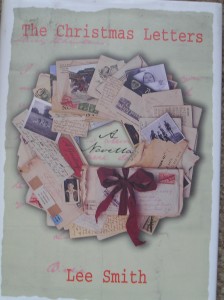The Blog
Every year during the holidays I like to read a Christmas novel. This year I chose The Christmas Letters, a novella by Lee Smith. Smith is a master of the epistolary form of fiction, as evidenced by her novel Fair and Tender Ladies, so I was sure this novella would be rich and satisfying. And it was, just not in the way I expected.
 The writing in The Christmas Letters is typical Smith, with authentic voices of southern women sharing their joys and heartaches. As I said in a review of Smith’s latest novel, Guests on Earth, no authors treat their characters with more dignity and respect than Smith. In The Christmas Letters, the voices she creates come from three generations of women carrying on the Christmas-letter-writing tradition. At first I was disappointed that the letters don’t talk as much about Christmas as I expected, so I didn’t get to feel like I was sharing in the holiday spirit with these characters. What I was sharing, I realized at the end, was the need of these women to reach out to family and friends—the need in all of us to let others into our lives and to feel welcome in theirs. If that’s not the spirit of Christmas, I don’t know what is.
The writing in The Christmas Letters is typical Smith, with authentic voices of southern women sharing their joys and heartaches. As I said in a review of Smith’s latest novel, Guests on Earth, no authors treat their characters with more dignity and respect than Smith. In The Christmas Letters, the voices she creates come from three generations of women carrying on the Christmas-letter-writing tradition. At first I was disappointed that the letters don’t talk as much about Christmas as I expected, so I didn’t get to feel like I was sharing in the holiday spirit with these characters. What I was sharing, I realized at the end, was the need of these women to reach out to family and friends—the need in all of us to let others into our lives and to feel welcome in theirs. If that’s not the spirit of Christmas, I don’t know what is.
The first voice in The Christmas Letters comes from Birdie Pickett, a woman who has left her family in West Virginia to live with her husband’s parents in North Carolina while he is fighting World War II in New Guinea in 1944. Birdie has just given birth to her daughter Mary, and she longs to be home with her family. She is “lonesome beyond words,” she says, but she will stay where her husband, Bill, wants her to stay and wait for him to come home.
Birdie’s next letter, written in 1951, is more upbeat, describing Bill’s return from the war and the addition of two more children to their family. Birdie tells in great detail about the days of rain that cause the flood that destroys Bill’s family’s farm. On the bright side, losing the farm forces them to take out a loan and open a dime store, which is a big success. Between the pieces of major news, Birdie muses about her children, their interests and what their future might be. She also describes her worry when her son, Joe, is drafted to go to Vietnam. Birdie’s final letter in 1967 starts by remembering Bill, who dies in August of that year.
The largest section of The Christmas Letters comprises the letters from Mary, beginning in the same year as her mother’s final letter. She’s married by then and living in a trailer park with her baby, Andrew, while her husband, Sandy, works construction. Mary’s happy in their little trailer, but she has insomnia, as does her neighbor Gerald, and they spend many summer nights outside passing away the hot hours. Mary’s 1975 letter talks about having twin girls, Melanie and Claire, and another son, James, and the family’s move to a house built by Sandy’s construction company. In 1985, Mary describes moving to another house, and swears she’ll never move again.
The tone of Mary’s letters is always light, revealing a woman who’s pleased with her life, enjoying her family and the volunteer work she does, despite her mother’s death and the disappearance of her brother, Joe. She even returns to college, a dream of hers for many years. So it’s a surprise when in her 1993 letter she reveals that she and Sandy have gotten a divorce. This letter, she says, is “a real Christmas letter, the first ever.”
In this letter, Mary describes the events leading up to the divorce. She also talks about why Joe disappeared after he returned from Vietnam, how her parents reacted when she and Sandy eloped, and the true story about her relationship with Gerald. This letter is the heart of The Christmas Letters.
In a message on the novella’s jacket, Smith says that with typical Christmas letters, “you have to read between the lines. … Sometimes what is not said is even more important than what is on the page. Every Christmas letter is the story of a life; often, the life of an entire family.”
I’m a dedicated Christmas-letter writer and have been for years. I’ve always tried to be honest in my letters, sharing the challenges our family has faced as well as our joys. I’m grateful to Lee Smith for cherishing Christmas letters as much as I do and devoting an entire novella to them. Christmas is a time for sharing with friends and family, and there’s no better gift than a part of yourself.
As for the Pickett family—Birdie, Mary, and the rest—I’m disappointed that The Christmas Letters includes only one letter from Mary’s daughter Melanie. I want to know what happened to them next.
Tags: Christmas, Lee Smith, novellas, Southern Writers
Get in Touch
Follow on Facebook
Follow on Twitter
___________________________________________________
Website Design by Eliza Whitney
 Posts from Late Last Night Books
Posts from Late Last Night Books



